.jpg.webp) Class 175 Coradia 1000 at Cardiff Central in 2009 | |
| Overview | |
|---|---|
| Franchise(s) | Wales & Borders 7 December 2003 – 13 October 2018 |
| Main region(s) | Wales |
| Other region(s) | North West West Midlands South West |
| Fleet size | 125 units 3 locomotive hauled sets |
| Stations operated | 247[1] |
| Parent company | Arriva UK Trains |
| Reporting mark | AW |
| Predecessor | Wales and Borders |
| Successor | KeolisAmey Wales |
| Technical | |
| Length | 1,623.8 km (1,009.0 mi) |
| Other | |
| Website | www.arrivatrains.co.uk |
Arriva Trains Wales[2] (ATW; Welsh: Trenau Arriva Cymru) was a British train operating company owned by Arriva UK Trains that operated the Wales & Borders franchise. It ran urban and inter-urban passenger services to all railway stations in Wales, including Cardiff Central, Cardiff Queen Street, Newport, Swansea, Wrexham General and Holyhead, as well as to certain stations in England such as Hereford, Shrewsbury, Chester, Crewe, Manchester Piccadilly and Birmingham New Street.
In August 2003, Arriva UK Trains was awarded the newly created Wales & Borders franchise by the Strategic Rail Authority, Arrival Trains Wales began operation during December 2003, taking over from Wales and Borders. Following the implementation of the Railways Act 2005 and Transport (Wales) Act 2006, responsibility for the franchise was devolved to the Welsh Government, which worked closely with Arriva Trains Wales during its period of operations. Numerous service changes were made under the company's management; on 6 February 2008, the Ebbw Valley Railway was partially re-opened to passenger services for the first time in over 40 years. Another high-profile change during December of that year was the inauguration of the locomotive-hauled Holyhead to Cardiff Premier Service.
In March 2010, Arriva Trains Wales' application to reinstate a direct Aberystwyth to London Marylebone service was rejected by the Office of Rail Regulation due to concerns over its financial viability, as well as the potential severe revenue abstraction from other operators such as Wrexham & Shropshire. In July 2012, the Department for Transport announced that the Cardiff Valley Lines would be electrified, although this ambition would not be substantiated during Arriva Train Wales' franchise period. During the mid-2010s, as the franchise period was nearing its end, tenders were sought for its next operator; Arriva Trains Wales' publicly withdrew from the process in October 2017 despite having been shortlisted. On 23 May 2018, KeolisAmey Wales was selected as the winning bid. On 13 October 2018, Arriva Trains Wales' franchise came to an end, operations being transferred to successor operator KeolisAmey that same day.
History
During March 2000, the UK government announced its plans to create a separate Wales & Borders franchise.[3] In October 2001, the two National Express-operated franchises, Valley Lines and Wales & West, were reorganised, after which the new Wales & Borders franchise assumed responsibility for the majority of services in Wales as shown on its map.[4] The services from Birmingham New Street to Chester, Aberystwyth, and Pwllheli operated by Central Trains were also transferred.[5] In October 2002, a shortlist of Arriva, Connex/GB Railways, National Express and Serco-Abellio were invited to bid for the new franchise period.[6][7]
On 1 August 2003, the Strategic Rail Authority awarded the new franchise to Arriva UK Trains.[8][9] The new franchise was for fifteen years, with performance reviews every five years; Arriva Trains Wales took over the services operated by Wales & Borders on 7 December 2003.[10] The next five-yearly review period concluded on 31 March 2013.[11] On 28 September 2003, the services from Birmingham New Street, Crewe and Manchester Piccadilly to Llandudno and Holyhead, as well as those between Bidston and Wrexham Central and between Llandudno and Blaenau Ffestiniog, operated by First North Western, were transferred to the new Wales & Borders franchise.[3][12]
As a result of the Railways Act 2005 and the Transport (Wales) Act 2006, responsibility for the franchise was later devolved to the Welsh Government.[13] Subsequently, the Welsh Government closely coordinated with Arriva Trains Wales in the management and development of the railway network within Wales. Changes included the introduction of direct services between North and South Wales,[14] and the reintroduction of passenger services on previously freight-only portions of the Vale of Glamorgan Line and Ebbw Vale Line.
At its height, ATW operated over a route length of 1691 km, with 253 diesel multiple unit (DMU) cars and 22 locomotive-hauled passenger carriages. Its busiest Welsh stations were Cardiff Central, Cardiff Queen Street and Newport in South Wales, and Bangor (Gwynedd) and Wrexham General in North Wales.
ATW operated almost all services in Wales, with the exception of:
- Pembroke Dock/Carmarthen/Swansea/Cardiff Central to London Paddington (Great Western Railway)
- Cardiff Central to Portsmouth Harbour or Taunton (Great Western Railway)
- Cardiff Central to Nottingham or Manchester Piccadilly (CrossCountry)
- Holyhead/Bangor/Wrexham General to London Euston (Virgin Trains West Coast)
- various heritage railways
Performance
In October 2006, ATW was ranked seventh best (out of 21 companies) with an above average 89.9% of trains 'on time' according to Network Rail statistics.[17] The latest figures released by NR (Network Rail) rate punctuality (Public Performance Measure) at 96.1% for period 7 of the 2013/14 financial year.[18] The MAA (Monthly Annual Average) figure for the 366 days up to 12 October 2013 is currently at 93.9%.[18]
In September 2017, a review on the conditions during a regular peak commute was published by 'Stu's Reviews'. This review was publicised through several of the national news networks, including Wales Online,[19] and BBC Wales.[20]
Welsh-language services
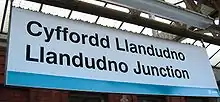
The Welsh Language Act 1993 requires all public bodies to provide services to the public through the medium of Welsh as well as English. As a private company and not a public body, Arriva Trains Wales was not legally required to provide service in Welsh,[21] but it did conduct some business in Welsh. All stations previously run by Arriva Trains Wales where the Welsh and English names differed had both names displayed, with a few minor omissions.[21] Arriva did not display Welsh names in the English stations which it managed, such as Chester (Welsh: Caer), Shrewsbury (Welsh: Amwythig), or Hereford (Welsh: Henffordd), but included the Welsh names in its now discontinued printed timetables and other publicity material.[22] There were bilingual signs at Hereford, for example, warning against trespassing on the railway.
Arriva Trains Wales introduced bilingual display screens and announcements in at least 46 stations.[23]
In 2004, ATW introduced a Welsh-language telephone line.[23] Its website was named the "Best Website of The Year in the Technology Wales Awards 2004".[24]
Routes
North Wales
Services along the North Wales Coast Line terminated at Holyhead and Llandudno. Llandudno services ran every hour to Manchester Piccadilly via Chester and Warrington Bank Quay. Holyhead services ran every hour, to Shrewsbury via Chester and Wrexham General, then alternately to Birmingham International or Cardiff Central. Request stations west of Llandudno Junction (Conwy, Penmaenmawr, Llanfairfechan, Llanfairpwll, Bodorgan, Ty Croes, Rhosneigr and Valley) were generally served by alternate trains. The Conwy Valley Line were operated by a single train running between Llandudno and Blaenau Ffestiniog, with six return journeys a day. The private Ffestiniog Railway operated connecting services between Blaenau Ffestiniog and Minffordd near Porthmadog.
Services on the Borderlands Line ran from Wrexham Central to Bidston on the Wirral Peninsula, crossing the North Wales Coast Line at Shotton. This line connected with main-line services at Wrexham General; with North Wales Coast line services at Shotton; and with electrified lines operated by Merseyrail at Bidston. It may be converted to electric operation in the future.[25][26]
Mid Wales
Cambrian Line services consisted of trains from Aberystwyth to Shrewsbury, Birmingham New Street and Birmingham International every two hours. Services from Pwllheli joined this train at Machynlleth. Services were operated exclusively by Class 158 Express Sprinters, as they were the only units fitted with the necessary equipment for the ERTMS system used on the line.[27]
The single-track nature of this line, coupled with the busy terminus at Birmingham New Street, meant that delays had in some cases resulted in partial cancellation of services on this line. Beginning December 2008, most services had been extended to the less busy Birmingham International station, giving more flexibility in making up any lost time; this was also intended to help international students at Aberystwyth University gain easier access to an airport.[28] The Heart of Wales Line had services from Swansea to Shrewsbury via Llanelli and Llandrindod four or five times a day. It was marketed by Arriva Trains Wales as a scenic, rural line, with special rover tickets available.[29][30]
South Wales
ATW operated an hourly long-distance service from Carmarthen to Manchester Piccadilly via Cardiff Central and the Welsh Marches Line. Some off-peak services terminated at or originated from Cardiff Central, and continued to or came from Milford Haven every two hours. There was also one service per day from Fishguard Harbour to Manchester Piccadilly, but not in the other direction. Some services operated to Tenby, Pembroke Dock, Carmarthen and Maesteg from Manchester Piccadilly.
ATW also operated a service every two hours from Cardiff Central to Holyhead via Wrexham General, other branches of the West Wales Line as served by trains from Swansea and Cardiff Central. Trains operated a shuttle service between Swansea and Cardiff Central (known as Swanline), calling at more minor stations than the Great Western Railway InterCity services did.[31][32]
ATW also operated the Heart of Wales line between Shrewsbury and Swansea via Llandrindod, with four trains per day in each direction. Special trains extending into South East Wales operated to Builth Road during the Royal Welsh Show annually in July.[33][34]
Cardiff and Valleys

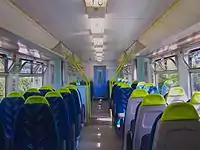
The Valley Lines network, previously operated as a separate franchise, was a collection of urban lines in Cardiff and the surrounding area, including the South Wales Valleys and the Vale of Glamorgan. Arriva Trains Wales also operated a service from Maesteg to Cheltenham Spa. Stations in the valleys north of Cardiff experienced strong passenger growth, as a result of which there was a new half-hourly service launched (Pontypridd-Treherbert, Abercynon-Aberdare, Abercynon-Merthyr Tydfil and in the future Bargoed to Rhymney). Service frequency growth at the fringes was a significant problem because of often lengthy single-track sections. Between the larger towns and Cardiff, these services combined to provide at least one train every 15 minutes, with six trains previously ran per hour between Pontypridd and Cardiff, and four trains per hour between Bargoed and Cardiff. Stations on the Treherbert and Rhymney branch lines were lengthened to accommodate six-car trains to cope with future growth demand for commuting into and out of the capital.
On 6 February 2008, the Ebbw Valley Railway was partially re-opened to passenger services for the first time in over 40 years. It provided an hourly service from Ebbw Vale Town railway station (opened 17 May 2015) to Cardiff Central calling at Ebbw Vale Parkway, Llanhilleth, Newbridge, Crosskeys, Risca and Pontymister, Rogerstone, Pye Corner, and Cardiff Central. One year after opening, the line had carried 573,442 passengers, beating all targets set by the Welsh Assembly Government. Saturday trains ran as four-car formations instead of the standard two. Extra carriages were also added during school holidays when demand was high.[35] Possible developments that never saw the light of day also included restoring the service between Ebbw Vale and Newport; before Arriva discontinued operations, the proposal awaited Network Rail and Welsh Government approval. If it has been implemented, it would have provided an hourly service between Newport and Ebbw Vale. Due to the end of Arrival Train Wales' operations, any further plans will now be implemented under TFW.[36][37]
In July 2012, the Department for Transport announced that the Cardiff Valley Lines would be electrified, although no timescale has been given. This will entail replacement of the life-expired Pacer railbuses by new or cascaded stock.[38] This project did not emerge within the Arriva Trains Wales era, and shall now occur under the auspices of successor operator TFW..[39]
Welsh Marches and Border
Services between Chester and Newport formed part of other ATW services already mentioned, such as Holyhead to Cardiff Central, or Milford Haven to Manchester Piccadilly. Coming north, after calling at Shrewsbury (for connections to Mid-Wales), trains for North Wales go to Chester via Wrexham General, and trains for Manchester go to Crewe.
Premier Service
A weekday Premier Service between Holyhead and Cardiff was introduced on 15 December 2008. This was run under contract to the Welsh Government.[40] Wrexham & Shropshire[41] and Grand Central[40] expressed an interest in operating the service, but the contract was awarded to Arriva Trains Wales.[40] At the time of the launch, it was known as Y Gerallt Gymro (Gerald of Wales),[40] it was subsequently named as the Premier Service.[42]
The Premium Service departed Holyhead at 05:34, returning from Cardiff departing at 17:16. It featured first-class accommodation and a full dining car with a travelling chef. Normal standard-class fares were valid on the train. First class attracted a supplement and included a complementary breakfast on the morning service and a three-course meal on the evening service. This was the only ATW service to offer first-class accommodation. It originally ran via Crewe but, in September 2012, the service was rerouted via Wrexham General, which required the train to change direction at Chester in addition to having its evening departure moved from 16:15.[43]
In December 2014, the Premier Service was rebranded as the Business Class Service in an move by Arriva Trains Wales to promote the service and specifically appeal to those travelling to and from Cardiff to work. Ticket prices remained the same and were still sold as first class, and the restaurant service remains, although tablecloths and antimacassars were removed to promote a more work-like environment.[44]
Special services
For special events, such as football or rugby matches, ATW commonly operated additional services to the venue. Wales & Borders had arranged in the past a stopping service to Edinburgh Waverley. Numerous other services have been operated. ATW usually operated shuttle services to Newport on match days. When rugby international matches are held at the Millennium Stadium, ATW often ran an extra Holyhead to Cardiff service using the Premier Service rolling stock. In April 2015, ATW were highly criticised and issued an apology for their continual poor performance when dealing with the Judgement Day rugby matches at the Millennium Stadium. Passengers were left queuing for hours due to the lack of services and lack of carriages available, some had to abandon their journeys for other means such as taxi and van hire. A spokesman for the company said “I want to assure all customers that every single train in Wales was out [on Saturday].” He added that the event differed to international rugby events, because the majority of those travelling to the matches travelled from south and south west Wales, placing huge pressure on specific routes.[45]
Former services
Arriva Trains Wales used to operate services from Manchester Piccadilly, Pembroke Dock, Carmarthen and Swansea to London Waterloo, Brighton, Portsmouth Harbour, Plymouth and Penzance via Cardiff, Bristol and Westbury. Services south of Cardiff are operated by Great Western Railway, while the Bristol Temple Meads to London Waterloo services are operated by South Western Railway
Rejected services
During late 2009, ATW filed an application to reinstate a direct Aberystwyth to London Marylebone service, serving all stations to Birmingham International and additionally calling at Leamington Spa and Bicester North.[46] As proposed, two off-peak trains would have operated each day, while a further service would have been added on Saturdays in high summer. Rolling stock would have been Class 158 Sprinters.
There were concerns voiced that, if ATW were granted this service, it would push Wrexham General to London Marylebone operator Wrexham & Shropshire out of business; Wrexham & Shropshire's Managing Director, Andy Hamilton, stated: "We believe that this proposal – if approved – would push the date of profitability of WSMR by at least a year. As a result of this our owning group would be unable to sustain additional and continuing losses and the WSMR service would cease to exist."[47] In March 2010, it was announced that the application has been rejected by the Office of Rail Regulation due to concerns about the financial viability of the service and the potentially high level of revenue abstraction caused to other operators.[48] Wrexham & Shropshire ceased to operate roughly one year later.[49]
Stations served
Major stations in Wales
Stations in England
Managed by Arriva Trains Wales
Managed by other companies
- Birmingham International (Avanti West Coast)
- Birmingham New Street (Network Rail)
- Crewe (Avanti West Coast)
- Earlestown (Northern)
- East Didsbury (Northern)
- Newton-le-Willows (Northern)
- Manchester Airport (TransPennine Express)
- Manchester Piccadilly (Network Rail)
- Manchester Oxford Road (Northern)
- Stockport (Avanti West Coast)
- Telford Central (West Midlands Railway)
- Warrington Bank Quay (Avanti West Coast)
- Wilmslow (Northern)
- Wolverhampton (West Midlands Railway)
- Stafford (Avanti West Coast)
- Bidston (Merseyrail)
- Gloucester (Great Western Railway)
- Cheltenham Spa (Great Western Railway)
Rolling stock
Arriva Trains Wales services were exclusively operated by diesel trains. This was largely due to there being no electrified railway lines in Wales at the time of the franchise. Arriva Trains Wales operated a fleet of 125 diesel multiple units. It also leased three locomotive-haul units for express services between Holyhead and Cardiff, and had occasionally used hired-in locomotives to run extra services for sporting events.
ATW inherited a fleet of Class 142, 143, 150, 153, 158 and 175s from Wales & Borders. The Class 175s were a common-user fleet, with 11 required by First TransPennine Express each day.
In the early years of the franchise, ATW operated locomotive-hauled services using Mark 2 carriages on services from Cardiff Central to Rhymney and Fishguard Harbour hauled by English Welsh & Scottish Class 37s and FiftyFund Class 50s, and from Crewe and Manchester Piccadilly to Holyhead hauled by Freightliner Class 47s and Virgin Trains Class 57s.[51] ATW built up a fleet of 20 Mark 2 carriages to operate these; all had been withdrawn by 2007, most of them being stored at Long Marston.[52]
Following the delivery of new stock to First TransPennine Express in 2006, all of the Class 175s became available to ATW, resulting in 16 Class 158s being released for transfer to other operators.[53]
In 2006, heritage unit 121032 was purchased by ATW for use on the Cardiff Bay Shuttle. The unit was overhauled by LNWR, Crewe,[54] entering service with ATW on 17 August 2006. In 2013, the unit suffered an engine failure. This could not be rectified, meaning that the unit was withdrawn. It was then used as a source of spare parts by sister company Chiltern Railways.
In November 2007, another nine Class 150s were transferred from Central Trains. From February 2008, five Class 150s (150278-282) were subleased to First Great Western. This was later reduced to four and then two, the last examples being returned during 2011.
In December 2008, the loco-hauled Holyhead to Cardiff Premier Service was inaugurated. It was initially hauled by Class 57s on hire from Virgin Trains, initially in top-and-tail formation and later singularly, hauling three standard class MK2s and a MK3 first/buffet. Four Class 57s were repainted at Cardiff Canton and six Mark 2s were refreshed at Eastleigh Works. During March 2012, newer Class 67 locomotives took over from the Class 57s, and Mark 3 carriages refurbished by Pullman Rail replaced the older Mark 2s in October 2012.[55][56] From October 2011 until August 2012, 150280 was subleased to National Express East Anglia/Abellio Greater Anglia. In December 2014, a further Mark 3 set was introduced on services from Manchester Piccadilly-Holyhead/Llandudno.[57][58][59]
| Family | Class | Image | Type | Top Speed | Number | Routes Operated | Built | |
|---|---|---|---|---|---|---|---|---|
| mph | km/h | |||||||
| Premier Service | 67 | .jpg.webp) |
Loco | 125 | 200 | 3 |
|
1999–2000 |
| Mark 3 |  |
Coach | 12 | 1975–1988 | ||||
| Driving Van Trailer |  |
Control car | 3 | 1988 | ||||
| Pacer | 142 | .jpg.webp) |
DMU | 75 | 121 | 15 | Valley Lines & Cardiff Local Routes | 1985–1987 |
| 143 |  |
15 | 1985–1986 | |||||
| Sprinter | 150/2 | .jpg.webp) |
DMU | 75 | 121 | 36[60] |
|
1986–1987 |
| 153 Super Sprinter |  |
8 | 1987–1988 | |||||
| 158/0 Express Sprinter | .jpg.webp) |
90 | 140 | 24 |
|
1990–1991 | ||
| Alstom Coradia | 175 Coradia 1000 | .jpg.webp) |
DMU | 100 | 161 | 27 | Regional services between North West England, North and South Wales | 1999–2001 |
| ||||||||
| Class | Image | Type | Top Speed | Built | Withdrawn | |
|---|---|---|---|---|---|---|
| mph | km/h | |||||
| 121 | 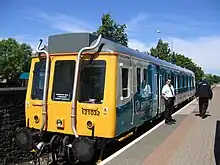 |
DMU | 70 | 112 | 1960 | 2013 |
| 57/3 |  |
Loco | 95 | 153 | 1964–1967 (rebuilt 1998–2004) | 2012 |
| Mark 2 | .jpg.webp) |
Coach | 100 | 160 | 1972–1975 | 2007–2012 |
Depots
Arriva Trains Wales' fleet were stabled at three depots.
- Chester (Alstom): Class 175
- Cardiff Canton: Class 142, Class 143, Class 150, Class 153 and Mark 3 stock.
- Machynlleth: Class 158
Demise
During the mid-2010s, as Arriva Trains Wales' 15-year franchise period came towards its scheduled end date, the process to select a successor was started. In October 2016, Abellio, Arriva, Keolis/Amey and MTR Corporation were shortlisted to bid for the next franchise.[61] During September 2017, the formal Invitation to Tender was issued.[62][63]
During October 2017, it was announced that Arriva was voluntarily withdrawing itself from the tendering process; the decision was reportedly viewed by some politicians as having raised questions about the franchise process.[64][65] In February 2018, rival firm Abellio also opted to withdraw, which was largely due to its partner company Carillion having effectively collapsed and entered liquidation one month earlier.[66]
On 23 May 2018, it was announced that KeolisAmey Wales has been selected to operate the next Wales & Borders franchise, which was set to run for 15 years, following the expiry of Arriva Trains Wales' franchise.[67][68]
References
- ↑ "Our Company". Arriva Trains Wales. Archived from the original on 2 February 2017. Retrieved 28 April 2017.
- ↑ "Arriva Trains Wales/Trenau Arriva Cymru Limited: company no. 4337645". Companies House extract. Archived from the original on 29 October 2013. Retrieved 27 May 2022.
- 1 2 "The Wales and Borders Franchise: House of Commons Select Committee on Welsh Affairs Third Report". Parliament. 17 March 2004. Archived from the original on 6 August 2017. Retrieved 30 August 2017.
- ↑ "Route map" (PDF). Wales & Borders. Archived from the original (PDF) on 14 June 2003.
- ↑ "More than just a new name for Wales & West in Wales". Wales & Borders. Archived from the original on 21 October 2001.
- ↑ "Four still in race for Wales & Borders". Rail Magazine. No. 446. 16 October 2002. p. 12.
- ↑ "Dutch plan a Welsh invasion". The Railway Magazine. No. 1221. January 2003. p. 6.
- ↑ "SRA Announces Preferred Bidder for New Integrated Wales Franchise" (Press release). Strategic Rail Authority. 1 August 2003. Archived from the original on 25 June 2016. Retrieved 25 September 2012.
- ↑ "Arriva to operate Wales & Borders". The Railway Magazine. No. 1230. October 2003. p. 35.
- ↑ "Passenger Franchise Information: Arriva Trains Wales". ATOC. 2008. Archived from the original on 5 March 2008.
- ↑ "Rail Franchising Timetable" (PDF). Department for Transport. 1 July 2012. Archived from the original (PDF) on 24 September 2012. Retrieved 16 October 2012.
- ↑ "First North Western in split". The Railway Magazine. No. 1202. June 2001. p. 11.
- ↑ "Transport: Rail". Welsh Government. 3 October 2012. Archived from the original on 30 June 2012. Retrieved 24 October 2012.
- ↑ Hulme, Chris. "North Wales Railway Notice Board – That new Arriva Timetable". Archived from the original on 14 October 2007. Retrieved 26 March 2008.
- ↑ "ATW Key stats". Archived from the original on 21 September 2017. Retrieved 20 September 2017.
- ↑ "ORR Passenger rail usage by TOC". Archived from the original on 21 September 2017. Retrieved 20 September 2017.
- ↑ "Public Performance Measure". Network Rail. Archived from the original on 4 December 2012. Retrieved 4 May 2013.
- 1 2 "Rail performance results period 7". Network Rail. Archived from the original on 4 December 2012. Retrieved 26 December 2012.
- ↑ "The shocking but all too common scenes filmed on one Welsh train journey". Wales Online. September 2017. Archived from the original on 28 January 2018. Retrieved 27 January 2018.
- ↑ "Arriva Trains Wales reports 'huge rise' in commuters". BBC News. September 2017. Archived from the original on 28 September 2018. Retrieved 20 June 2018.
- 1 2 Clark, Rhodri (5 January 2005). "Train firm's web site hits the buffers over Welsh language". Western Mail. Cardiff. Retrieved 15 April 2008.
- ↑ "Welsh signs would be on wrong track". Hereford Times. 8 January 2004. Archived from the original on 18 April 2012. Retrieved 20 October 2013.
- 1 2 "Rail company launches Welsh language phone line" (Press release). Arriva Trains Wales. 10 June 2004. Archived from the original on 25 October 2013. Retrieved 23 June 2013.
- ↑ "Arriva Trains Wales secures top internet communications award" (Press release). Imaginet. 28 May 2004. Archived from the original on 24 September 2015. Retrieved 20 October 2013.
- ↑ "Provisional North Wales Regional Transport Plan (Appendix 2- Railway Development in North Wales" (PDF). Archived from the original (PDF) on 24 September 2015. Retrieved 20 October 2013.
- ↑ "Network RUS Electrification" (PDF). October 2009. Archived from the original (PDF) on 12 October 2014. Retrieved 20 October 2013.
- ↑ "ERTMS gets tested in Wales". European Railway Review. 15 February 2010. Retrieved 16 September 2010.
- ↑ "2008 timetable alteration summary" (PDF). saveseverntunnel.co.uk. Archived from the original (PDF) on 7 January 2009. Retrieved 7 July 2008..
- ↑ "The Heart of Wales Line". Arriva Trains Wales. Archived from the original on 21 October 2013. Retrieved 20 October 2013.
- ↑ "Discover Wales and the Borders by Train – Your Guide to Arriva Trains Wales' Rovers and Rangers". Arriva Trains Wales. Archived from the original on 28 July 2011. Retrieved 25 August 2008.
- ↑ "Angry rail firm blames cuts in service on Welsh councils". LocalGov. Archived from the original on 22 July 2011. Retrieved 11 April 2011.
- ↑ "Route Utilisation Strategies - Wales" (PDF). Network Rail.
- ↑ "Extra trains to be put on for Royal Welsh". Wales Online. 30 March 2013.
- ↑ "Special train running from Cardiff to the Royal Welsh Show". Powys County Times. 10 July 2010.
- ↑ "Ebbw Valley rail link marks first successful year". South Wales Argus. Newport. 10 February 2009. Archived from the original on 13 February 2009. Retrieved 24 March 2009.
- ↑ Shipton, Martin (12 August 2006). "Ebbw Vale-Newport rail link put back into next decade (from National Union of Rail, Maritime and Transport Workers)". National Union of Rail, Maritime and Transport Workers website. Western Mail. Archived from the original on 20 July 2011. Retrieved 11 August 2010.
- ↑ "Ebbw Vale to Newport rail decision 'in 2011'". BBC News. 20 July 2010. Retrieved 20 July 2010.
- ↑ "Rail electrification to Swansea and south Wales valleys". BBC News. 16 July 2012. Archived from the original on 18 July 2012. Retrieved 20 June 2018.
- ↑ "Cardiff And Valleys Station Upgrades". Network Rail. 16 May 2018. Archived from the original on 17 May 2018. Retrieved 16 May 2018.
- 1 2 3 4 Clark, Rhodri (15 December 2008). "Cost of subsidised rail service a secret". Western Mail. Cardiff. Archived from the original on 18 October 2015. Retrieved 20 October 2013.
- ↑ Clark, Rhodri (26 April 2008). "Trains carry true taste of Wales". Western Mail. Cardiff. Archived from the original on 18 October 2015. Retrieved 20 October 2013.
- ↑ "North-South Wales Premier Service". Arriva Trains Wales. Archived from the original on 20 October 2013. Retrieved 20 October 2013.
- ↑ "All Change for the Premier Service". North Wales Coast Railway Notice Board. 20 September 2012. Archived from the original on 30 October 2012. Retrieved 26 September 2012.
- ↑ "First class to be retained on controversial North to South Wales train after U-turn". Daily Post. Archived from the original on 31 January 2016. Retrieved 24 January 2016.
- ↑ "Train company apologises after rugby fans left fuming over Judgement Day services". Wales Online. Archived from the original on 27 April 2015. Retrieved 27 April 2015.
- ↑ "Arriva Trains Wales Announces Plans for Direct Aberystwyth – London Services" (PDF). Railtalk Magazine. No. 28. January 2009. p. 50. Retrieved 24 October 2012.
- ↑ "DB Regio to cease funding WSMR if Arriva runs in to London". Rail Magazine. No. 630. Peterborough. 4 November 2009.
- ↑ "Aberystwyth to London direct rail route rejected". BBC News. 1 March 2010. Archived from the original on 4 March 2010. Retrieved 1 March 2010.
- ↑ "Wrexham-Shropshire-London direct rail link to end". BBC News. 26 January 2011. Archived from the original on 29 June 2016. Retrieved 20 June 2018.
- ↑ Geographically on the English side of the Border
- ↑ "Rail 37 Galleries". Archived from the original on 20 October 2013. Retrieved 16 October 2012.
- ↑ Rail Magazine. No. 562. Peterborough. 28 March 2007. p. 45.
{{cite magazine}}: Missing or empty|title=(help) - ↑ "The Alstom Class 175 DMUs". Today's Railways UK. No. 184. April 2017. pp. 40–47.
- ↑ Rail Magazine. No. 544. Peterborough. 19 July 2006. p. 23.
{{cite magazine}}: Missing or empty|title=(help) - ↑ "Changeover day". North Wales Coast Railway Notice Board. 26 March 2012. Archived from the original on 30 July 2013. Retrieved 25 September 2012.
- ↑ "Gerald's Big Day...happens!". North Wales Coast Railway Notice Board. 15 October 2012. Archived from the original on 30 October 2012. Retrieved 16 October 2012.
- ↑ "Green light for extra services between England and Wales". Department for Transport. 16 July 2014. Archived from the original on 3 September 2014. Retrieved 30 August 2014.
- ↑ "New North Wales to Manchester train services launched in £1.2 million deal". Daily Post. 16 July 2014. Archived from the original on 3 September 2014. Retrieved 30 August 2014.
- ↑ "'Irish Mancurian' is Go". North Wales Coast Railway Notice Board. 21 July 2014. Archived from the original on 3 September 2014. Retrieved 30 August 2014.
- ↑ "Fleet - Class 150 - Arriva Trains Wales". Porterbrook. Archived from the original on 11 July 2018. Retrieved 11 July 2018.
- ↑ "Wales & Borders bidders asked to propose Metro options". Railway Gazette International. 13 October 2016. Archived from the original on 19 October 2016. Retrieved 20 October 2016.
- ↑ "DfT Rail Franchise Schedule" (PDF). Archived (PDF) from the original on 23 November 2015. Retrieved 13 December 2015.
- ↑ "Wales & Borders franchise invitations to tender issued". Railway Gazette. Archived from the original on 11 December 2017. Retrieved 10 December 2017.
{{cite news}}: CS1 maint: bot: original URL status unknown (link) - ↑ "Arriva pulls out of Wales & Borders franchise contest". International Railway Journal. 30 October 2017. Archived from the original on 7 November 2017. Retrieved 31 October 2017.
- ↑ "Arriva Trains Wales drops out of Welsh rail franchise bid". BBC News. 30 October 2017. Archived from the original on 19 June 2018. Retrieved 20 June 2018.
- ↑ Gerrard, Bradley (23 February 2018). "Abellio pulls out of rail bid after Carillion collapse". The Telegraph. Archived from the original on 24 February 2018. Retrieved 23 May 2023.
- ↑ "Wales' trains to be run by European firms KeolisAmey". BBC News. 23 May 2018. Archived from the original on 23 May 2018. Retrieved 23 May 2018.
- ↑ "New trains and more services in £5bn deal". BBC News. 4 June 2018. Retrieved 4 June 2018.
External links
 Media related to Arriva Trains Wales at Wikimedia Commons
Media related to Arriva Trains Wales at Wikimedia Commons- Arriva Trains Wales official website
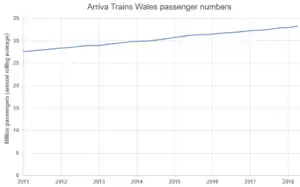
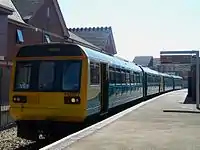
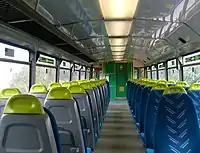
.jpg.webp)